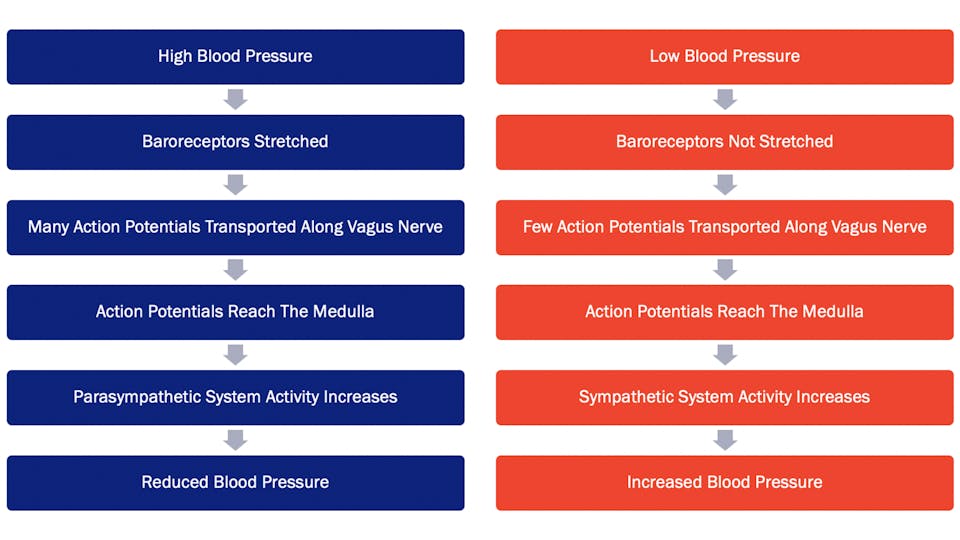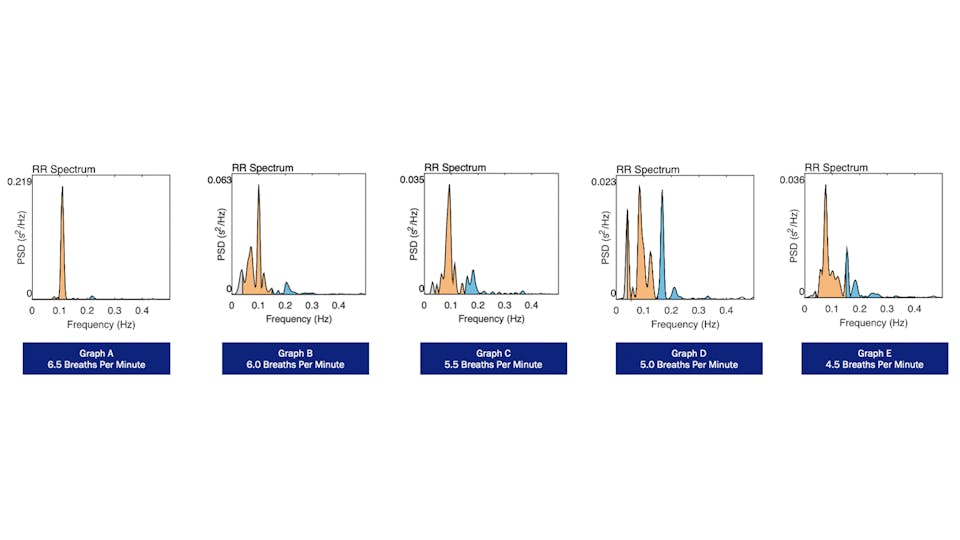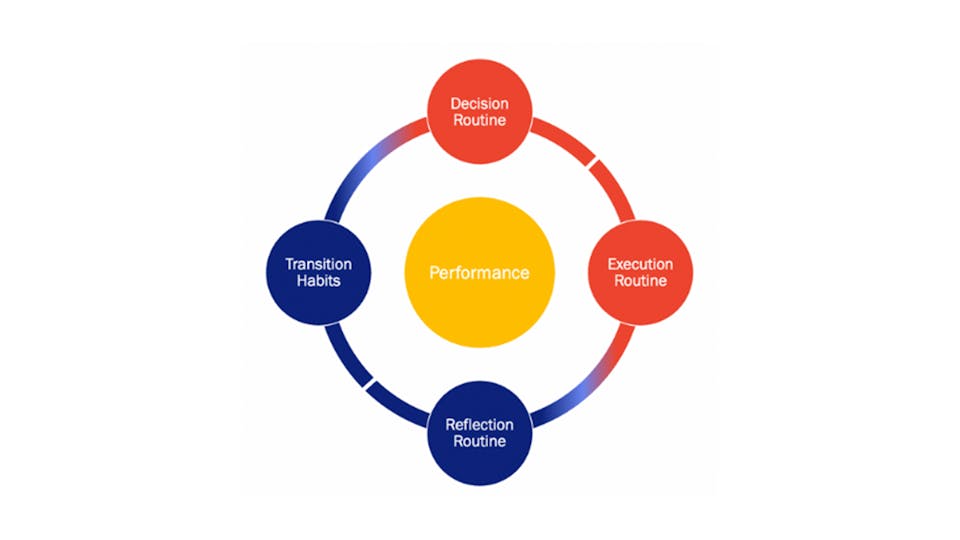Ultimate Guide To On-Course Breathing
Just relax and take a deep breath.
While this is well-intended advice, it lacks specificity.
Ask yourself the following question:
How can you calm the mind if your body is physiologically in a state of fight or flight?
Many of our well-intended efforts are directed at combatting symptoms of stress rather than the root cause. In other words:
“The vast majority of relaxation techniques aim to relieve the psychophysiological symptoms of stress rather than address the source of autonomic imbalance in the body.”
Proper breathing doesn’t guarantee a good golf shot. However, we can minimize stress-induced drops in golf performance and improve our golf fitness by learning how to control our physiological stress response. The best way to do that is to breathe properly.
This article is divided into three parts centered around developing an understanding of resonance frequency breathing (RFB). I will cover:
- What RFB is
- How to do RFB
- How to incorporate RFB on the golf course
Autonomic Nervous System
First, let’s cover the impact breathing has on our bodies.
Our body is always trying to maintain balance. Homeostasis is the tendency of any living system to maintain physiological equilibrium.
The autonomic nervous system (ANS) plays a role in maintaining homeostasis.
The ANS is composed of two subsystems:
- Sympathetic nervous system (SNS)
- Parasympathetic nervous system (PNS)
Sympathetic Nervous System Overview
The purpose of the SNS is to prepare the body for strenuous activity.
Activation of the SNS results in the release of epinephrine and norepinephrine.
The physiological changes due to activation of the SNS include increased blood pressure, heart rate, and blood sugar.
SNS activity also increases blood flow from our extremities towards our core. This results in a loss of tactile sensations. For golfers, losing our sense of touch negatively impacts our ability to hit shots the way we want to. This loss of tactile sensation in our hands results in golfers squeezing the grip of their club tighter than they normally would if their SNS wasn’t as active. This is to compensate for the loss of tactile sensation.
Overall, we want to avoid unnecessarily activating the SNS during golf tournaments.
Parasympathetic Nervous System Overview
The purpose of the PNS is to conserve energy.
Activation of the PNS results in the release of acetylcholine.
Physiological changes due to activation of the PNS include:
- Decreased blood pressure and heart rate
- Increased vagal tone (explained later in the article)
The PNS has a calming effect on the body. We want to activate the PNS whenever possible during a golf tournament.
Which One Is “Better”?
The SNS and PNS have opposite effects on the body. Neither system is inherently “good” or ”bad”.
Rather, they both serve a distinct purpose. We need both systems to maintain homeostasis.
If our body perceives a threat, it will trigger a SNS response. This is a survival mechanism. If our body doesn’t perceive a threat, the PNS will be activated.
Have you ever wondered why hitting a golf ball on the range and the first tee doesn’t feel the same? It’s partly because of our physiological response to a perceived threat.
The key to thriving under pressure is convincing your body that an excessive SNS response is not necessary.
Vagus Nerve & Vagal Tone
The vagus nerve is the longest nerve in the body. It facilitates communication between the heart and brain.
The vagus nerve sends information to brain regions that are important in stress response.
Vagal tone is the activity level of the vagus nerve. Eliciting a PNS response causes increased vagal tone.
Vagal tone (and heart rate) decreases during inhalation and increases during exhalation. That’s why many breathing techniques suggest exhaling longer than inhaling.
This increase in heart rate while inhaling and decrease while exhaling is known as respiratory sinus arrhythmia (RSA).
Increasing vagal tone activity is a practical way to reduce physiological stress.
An increase in vagal tone results in a slower heart rate and increased PNS activity.
Baroreflex
Our blood pressure is regulated by the baroreflex. This is the homeostatic system that regulates blood pressure.
Specifically, our blood pressure is monitored by blood pressure receptors known as baroreceptors.
Baroreceptor activation inhibits the SNS and activates the PNS.
To maintain homeostasis the baroreflex is constantly adjusting our blood pressure.
The diagram below illustrates how this dynamic system works.
In the diagram below the term “action potentials” simply refers to explosions of electrical activity.

Managing Blood Pressure On-Course
Moving from a crouched position to a standing position causes a rapid drop in blood pressure. This increases SNS activity to increase blood pressure.
The golf game forces us to transition from a crouched to a standing position frequently during a round.
Reading a putt and teeing up a golf ball both result in a rapid decrease in blood pressure when we stand up.
In response to this drop in blood pressure, our baroreflex restores homeostasis by increasing SNS activity to increase blood pressure (see the orange column in the diagram above).
Increased SNS activity is the last thing we want prior to hitting a delicate putt, or a drive requiring distance and accuracy.
Heart Rate Variability
Heart rate variability (HRV) is the variance in time between the beats of your heart.
The fluctuations in time intervals between heartbeats are caused by the SNS and PNS interaction. The constant signals from both systems cause there to be a fluctuation in heart rate.
High HRV is desirable because it is an indicator of our ability to adapt to the environment.
Low HRV indicates that one system is dominating and sending stronger signals to the body. The dominating system is often the SNS.
Resonance Frequency
The resonance frequency is the unique breathing rate that:
- best stimulates the baroreflex
- creates the most HRV
- maximizes RSA
- increases low-frequency activity (explained in the video below)
Resonance frequency breathing (RFB) is achieved by breathing at a pace between 5-7 breaths per minute. The breathing pace that elicits the greatest response varies for each individual.
Breathing at your resonance frequency is achieved when there is synchrony between respiration rate and heart rate.
See the video below for a thorough explanation of resonance frequency.
Resonance Frequency Breathing Recap
In Golf fitness, resonance frequency breathing (RFB) is a powerful tool to manage the physiological stress we encounter during competition.
Instead of addressing the symptoms of stress, we can now address the underlying issue - a lack of balance between the SNS and PNS (autonomic imbalance).
RFB allows us to restore autonomic balance.
See the video below for a recap of the underlying mechanisms of RFB:
Through RFB we can limit SNS activity and increase PNS activity on-demand. This allows us to control our physiological response to stress while on the golf course.
Instead of avoiding stress on the golf course, we have to learn how to manage stress.
Learn to control your physiology, otherwise, it will control you.
Practicing Resonance Frequency Breathing
Breathing pacer apps such as NeuroPeak Pro and Kardia (both free) are invaluable tools.
Both apps allow you to customize the inhale, exhale, and breath-hold settings.
A good starting point is setting the pacer app to the following settings:
- Inhale - 4 seconds
- Hold - 1 second
- Exhale - 4 seconds
- Hold - 1 second
While the exact resonance frequency differs for each individual, breathing between 5-7 bpm will ensure you are activating the SNS.
Resonance Frequency Breathing Technique
Set-Up
- Sit/stand tall with chest open
- Hand(s) placed on the stomach
- Inhale and exhale through your nose with your tongue resting on the roof of the mouth
- Breathe at a pace between 5-7 bpm
Cues
- On the inhale push your belly button down and outwards towards your knees
- On the exhale pull your belly button down and inwards towards your tailbone
Checkpoints
- No visible movement in the chest during inhale and exhale
- The stomach expands and contracts throughout the breathing cycle
Why Nasal Breathing?
Nasal breathing is a crucial part of RFB and is beneficial for general health.
We are designed to breathe through our noses.
“Humans are naturally designed to breathe through our noses from birth. It’s the way we’ve evolved…When we’re newborns, we breathe in and out through our noses almost all the time. This is related to how our throats are configured, so we can breathe and suckle at the same time without choking. It’s a survival mechanism.”
While many of us might have developed a habit of mouth breathing, the mouth isn't designed to be our primary breathing pathway.
The benefits of nasal breathing include:
- Temperature control - Control over the temperature of the air that enters our body.
- Filtering - Filtering out toxins in the air that get sent to the gut instead of the lungs. Mouth breathing doesn't allow for this filtering process to occur.
- Humidify - The nasal passage humidifies the air we inhale allowing us to maintain moisture within the body. Waking up in the morning with a dry mouth is a sign of mouth breathing.
- Oxygen delivery - Oxygen is efficiently delivered to the working tissues. This means the working tissues are being supplied with the fuel they need to work.
- Breathing Efficiency - Forces air to reach tissues at the back of the throat which makes the airways wider and makes breathing easier. Through consistent nasal breathing over time, the tissues and muscles adapt and learn to stay in this open and wide position. This encourages more nasal breathing. Essentially, nasal breathing becomes easier over time.
- SNS Activation - Nasal breathing helps us engage our diaphragm. Using our diaphragm is important in supporting PNS activation
Many people think it is “easier” to breathe through their mouth, however, this is not the case. When we mouth breathe our tongue is on the floor of the mouth, which closes the airways. This contributes to a SNS response.
Barriers to Resonance Frequency Breathing
There are four major barriers to RFB:
- Eating
- Drinking
- Talking
- Strenuous exercise
What do these four things have in common that is relevant for golfers?
These are all things we do on the golf course.
In between shots, we eat snacks, drink water, and talk with our caddy and/or playing partners. We may occasionally engage in strenuous exercise by jogging up a hill to a tee box or a green to save time.
All these situations inhibit us from breathing through our noses.
And as I mentioned earlier, mouth breathing increases SNS activity, putting us physiologically in a state of stress. This is not what we want to be doing as we approach our next shot.
As an example, imagine you hit your tee shot and then proceed to walk towards your ball a few hundred yards away in the fairway. You start walking and grab a snack out of your golf bag. Once you finish your snack, you grab your water bottle and take a few sips. Then you still have a minute until you reach your golf ball, so you start a conversation with your playing partner. You finally arrive at your ball and start talking with your caddy. For the past few minutes since you left the tee box you have been engaging in activities that have been sending low-level SNS signals to your body.
Now we face a difficult approach shot over water which further triggers a SNS response.
Poor breathing habits cause us to miss out on opportunities to send PNS signals to our bodies to counteract the stresses of tournament golf. Instead, we add unnecessary SNS signals to an already stressful situation.
Optimizing Golf Performance
RFB can be used to optimize golf performance. This is a four-step process.
- Identify resonance frequency
- Develop breathing practice
- Develop golf performance process
- Monitor and adjust
Step 1 - Identify Resonance Frequency
Conducting a resonance frequency assessment allows us to identify an individual’s unique resonance frequency.
The assessment protocol is as follows.
While wearing a heart rate monitor and following a breathing pacer, the golfer breaths for 3 minutes at five different breathing rates. The breathing rates are:
- 6.5 bpm
- 6.0 bpm
- 5.5 bpm
- 5.0 bpm
- 4.5 bpm
Below is an example of data collected at each of the five different breathing rates.

Based on the five graphs above, this individual’s resonance frequency is 6.5 bpm.
If these graphs are confusing to you, please review the previous sections.
Step 2 - Develop Breathing Practice
Now we can develop a breathing practice based on our resonance frequency.
The goal is to improve our ability to activate the PNS.
I recommend a total of 60 minutes of RFB each week broken down into 10-minute sessions (6-7 sessions/week)
At first, start from a seated position. As you get comfortable with this, progress to practicing RFB from a standing position.
Practicing from a standing position helps with transferring RFB to the golf course.
We don't want to practice for the sake of practice. The purpose of practicing RFB regularly is to help you activate the PNS on demand while on the golf course.
Step 3 - Golf Performance Process
The Golf Performance Process (GPP) is the model I use to teach on-course routines.
The diagram below illustrates the GPP:

The video below provides an overview of the GPP:
Step 4 - Monitor and adjust
There are three main ways we can monitor and adjust the GPP.
- Observe - Filming a golfer’s on-course routines on a regular basis allows us to track changes in their GPP over time.
- Collect Data - Use technology, such as the NTEL BELT, to collect real-time data. This allows us to measure a golfer’s PNS and SNS activity levels on the golf course.
- Breathing Pacer - Have golfers listen to audio that provides breath pacing at their resonance frequency while playing on the course.
- Player Feedback - Communication between player and coach can provide valuable insights into how the GPP is impacting the player’s performance.
Importantly, observing, collecting data, and using a breath pacer can be used together. We can observe and film their GPP while collecting real-time data, while they are being cued by a breathing pacer.
Four-Step Process Review
The order of this four-step process is not random. Each step builds on the previous one.
Identifying the resonance frequency (step 1) allows us to develop a more effective breathing practice (step 2).
Through training RFB (step 2) you can change your physiological response to stress.
By being able to activate the PNS on-demand (through practice), you can develop a more efficient GPP (step 3).
If you don't implement the golf performance process (step 3) and don't have a breathing practice (step 2), there is nothing for you and your team to monitor and make adjustments to (step 4).
Conclusion
We’ve covered both the science behind RFB and its practical application for golf. I encourage you to spend time developing your own GPP based on the concepts covered in this article.
Below is a comprehensive presentation of the content covered in this article.
If you feel overwhelmed and need help getting started please Contact us today to schedule an assessment.

Are you ready to improve your game?
Book your assessment today by clicking the button below. We'll call you to schedule your visit.
